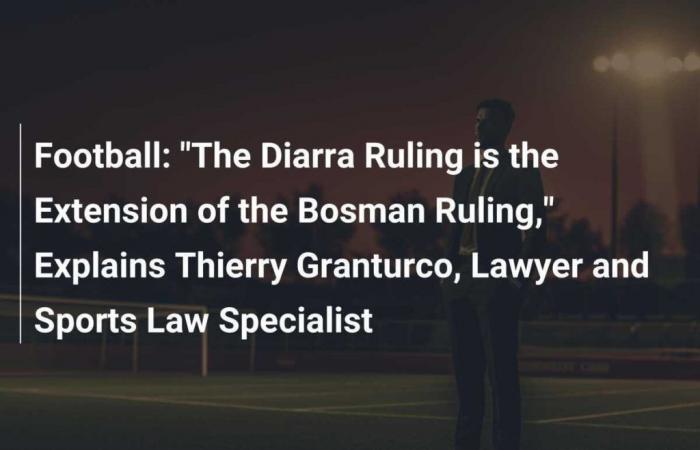
The Court of Justice of the European Union has ruled in favor of former footballer Lassana Diarra, who took FIFA to task following his departure from Lokomotiv Moscow in 2014. Diarra contested the €20 million compensation sought by his former club, which claimed that the French midfielder had terminated his contract without valid reason. The CJUE stated on Friday, October 4, that certain FIFA regulations concerning transfers between clubs are “contrary” to EU law and “are likely to hinder the free movement” of professional footballers.
This ruling has been viewed by some football observers as the beginning of a revolution, a Bosman 2.0. The original Bosman ruling from 1995 arose from a dispute between Belgian footballer Jean-Marc Bosman and RFC Liège, the club that prevented him from signing with Dunkirk. It eliminated the (very limited) quotas of foreign players in European leagues and drastically changed the landscape of international football. Thierry Granturco, a lawyer and specialist in sports law, shares his thoughts with Franceinfo: sport on the potential ramifications of what is already being dubbed the “Diarra Ruling.”
Franceinfo: sport: Is the decision of the Court of Justice of the European Union a new Bosman ruling?
Thierry Granturco: I would say rather that it is an extension. The principle established in 1995 was that no international transfer should be rendered impossible by unreasonable transfer fees. At that time, we were only discussing transfer fees set between clubs. With the Diarra ruling, these limitations extend to the compensation that can be requested from a player if they breach their contract. What the Court of Justice states is that, regardless of the methods employed by clubs and agents, it is out of the question to hinder the free movement of a worker through any fee, whether paid from one club to another, or from a player to their club, to render a transfer financially impossible.
Is the implementation of this ruling immediate, or do additional steps need to be taken?
The decision is self-sufficient. The ruling can be immediately transposed into the legal practices that will follow. Compensation will have to be calculated in a serious manner, no longer based on the whimsical approach it previously had. However, it is likely that we will see a situation similar to what occurred right after the Bosman ruling. Based on this ruling, the European Commission, as well as FIFA and UEFA, will have to convene and consider what to do with this decision. Can a contract be terminated at any time, outside the transfer windows? I strongly doubt it. The ruling seems to suggest: “We need to change how we calculate compensation for breaches, but we leave it to football authorities to determine how to practically resolve this.”
“We are increasingly liberalizing the transfer market by lowering the compensation demands of the actors involved.”
Should we expect the next transfer window to already be transformed?
Very clearly. If in the next transfer window you do not want to sell your player, you will ask for €50 million, knowing full well that beyond €10 million he is unsellable. You will certainly find yourself facing agents and players who will reference the Diarra ruling. Everything we have experienced so far, where we merely put a finger in the air to set a figure for compensation, will have to transition into a more rational calculation.
What about excessive release clauses that have become common?
In Spain, for a little over three seasons, release clauses approaching €1 billion have been included in the contracts of certain prospects. This directly obstructs the free movement of workers. These clauses will very likely find themselves before judicial authorities in case of a blockage.
However, as long as all parties agree, it will still be possible to see sums going up to €200 million. If the seller, buyer, and player are in agreement, there is no obstruction. Kylian Mbappé and other international stars, in my view, will escape this ruling. I believe it will more significantly affect the class of players just below them, those very good Ligue 1, Premier League, or Bundesliga players recruited for sums ranging from €30 to €50 million. We can imagine that the stakeholders will become more cautious, leading to significant changes, particularly for clubs’ revenues that are already experiencing difficulties and risk seeing a source of funding dwindle.
Does the Diarra ruling serve as an additional argument for supporters of the Super League or any other closed league project?
It again jeopardizes clubs’ revenues. It adds uncertainty to uncertainty. There is obviously a sporting aspect: what will my ranking be at the end of the season, and thus the amount that will be attributed to me in terms of TV rights? It is evident that it is very difficult to sell TV rights at the level of expectations held by club executives.
Ultimately, the Court of Justice is making further strides in the liberalization of the football economy. The next step could be the establishment of private leagues. The same Court of Justice has already indicated that such leagues are legally compatible with European law. These closed leagues may facilitate the management of this uncertainty since there would be no promotion or relegation; we would know beforehand what the revenues and expenses will be.



